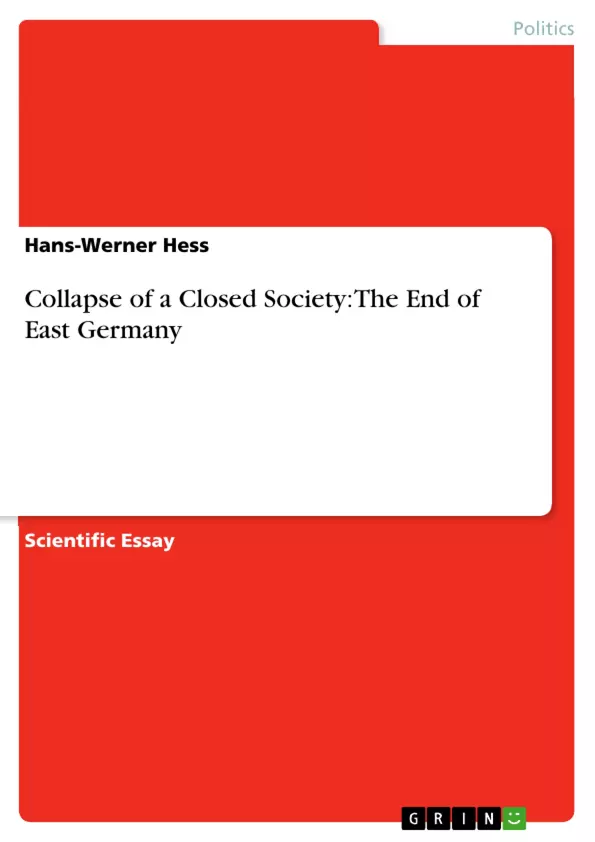The paper was addressed to an East-Asian audience conscious of national ‘unification’ demands in their own region, familiar with life in an authoritarian system, and aware of criticism of ‘Western’ political freedoms. Against this backdrop, it interprets the collapse of the German Democratic Republic in summer/fall 1989 within the framework of Karl Popper’s and Ralf Dahrendorf’s ‘closed society’ paradigm. It concludes that the East German system imploded because of pervasive popular disillusion in light of growing contradictions between official rhetoric and actual economic failure. It was not in the interest of the East German population to reform the existing structures but to pursue a quick path towards reunification with the West. Reunification demands were thus not primarily based on patriotic (or nationalist) discourse but on rational political choice.
Inhaltsverzeichnis (Table of Contents)
- Summer/Autumn 1989: The 'Spark of Hope'
- The 'Closed Society' of the GDR: Primacy of Ideology
- The Failure of the GDR Economy
- The Disillusionment
- The Dissolution: The ‘Opportunity Cascade' of 1989
Zielsetzung und Themenschwerpunkte (Objectives and Key Themes)
This paper examines the collapse of the German Democratic Republic (GDR) in 1989, focusing on the societal and political factors that contributed to its demise. The paper interprets the events within the framework of Karl Popper's and Ralf Dahrendorf's 'closed society' paradigm. It argues that the GDR's downfall resulted from widespread popular disillusionment caused by the growing contradictions between official rhetoric and the economic realities of the state.
- The role of the 'closed society' paradigm in understanding the GDR's collapse
- The impact of Mikhail Gorbachev's reforms in the Soviet Union on the GDR
- The significance of the mass exodus of East Germans in 1989
- The role of popular protests and demonstrations in triggering the GDR's downfall
- The 'opportunity cascade' and the increasing boldness of the East German population
Zusammenfassung der Kapitel (Chapter Summaries)
- Summer/Autumn 1989: The 'Spark of Hope': This chapter discusses the events of 1989 in the GDR, including the mass exodus of East Germans and the growing popular unrest. It uses Dahrendorf's concept of 'closed societies' to explain the dynamics of the revolution.
- The 'Closed Society' of the GDR: Primacy of Ideology: This chapter delves into the nature of the GDR's political system, its ideology, and the limitations imposed on its citizens.
- The Failure of the GDR Economy: This chapter examines the shortcomings of the GDR's centrally planned economy and the economic hardships faced by its citizens.
- The Disillusionment: This chapter analyzes the growing disillusionment among East Germans with the socialist system and the government's inability to address their grievances.
Schlüsselwörter (Keywords)
Closed society, German Democratic Republic (GDR), East Germany, 1989 revolution, popular uprising, mass exodus, economic failure, political disillusionment, opportunity cascade, reform, reunification, socialist system, authoritarianism, perestroika, glasnost, Ralf Dahrendorf, Karl Popper.
- Arbeit zitieren
- Dr. Hans-Werner Hess (Autor:in), 2010, Collapse of a Closed Society: The End of East Germany, München, GRIN Verlag, https://www.grin.com/document/153053



